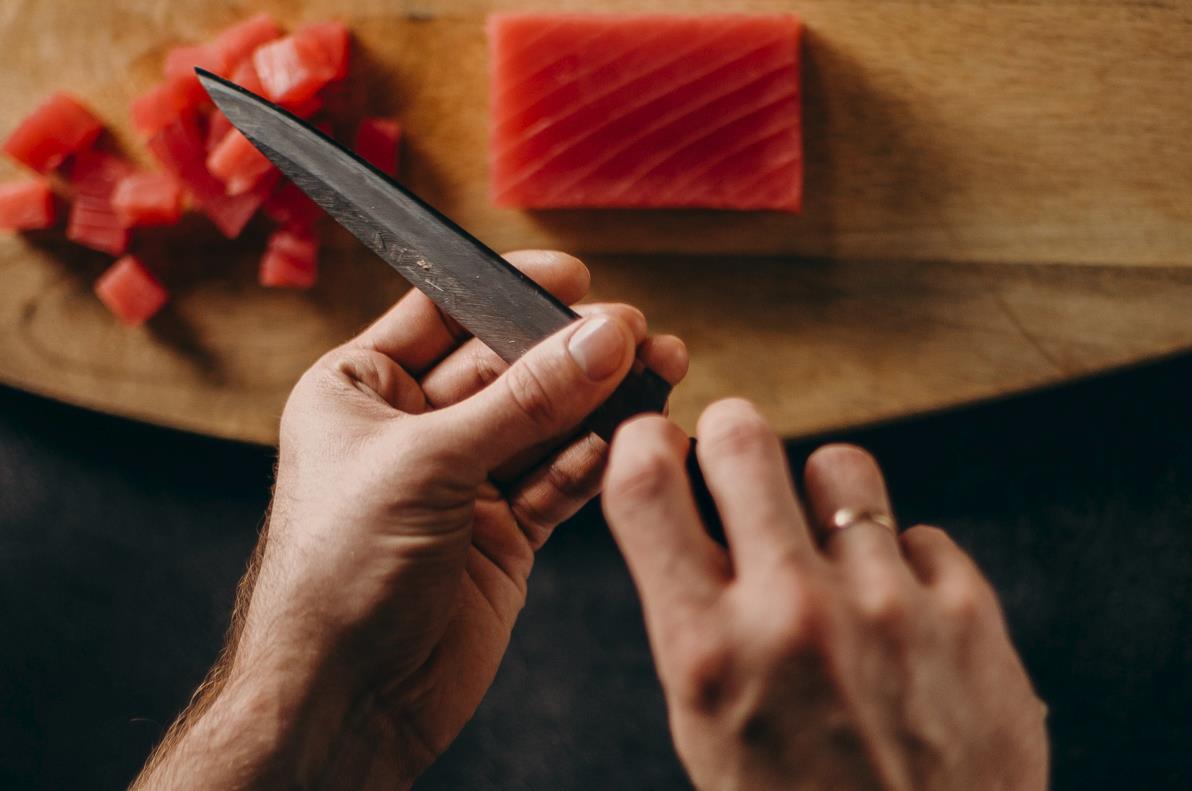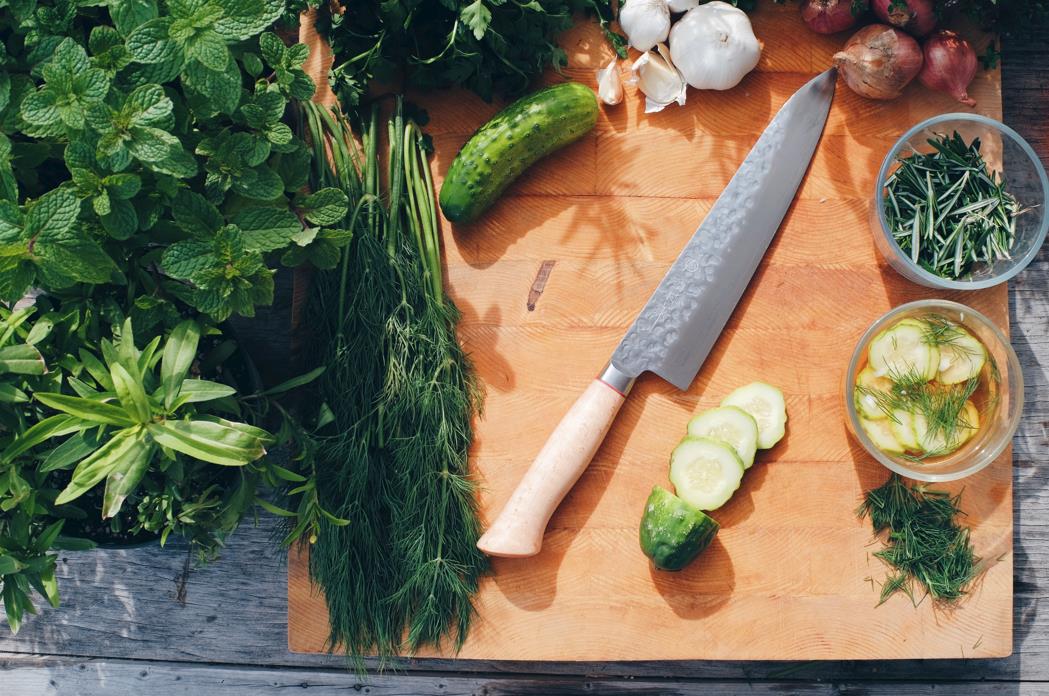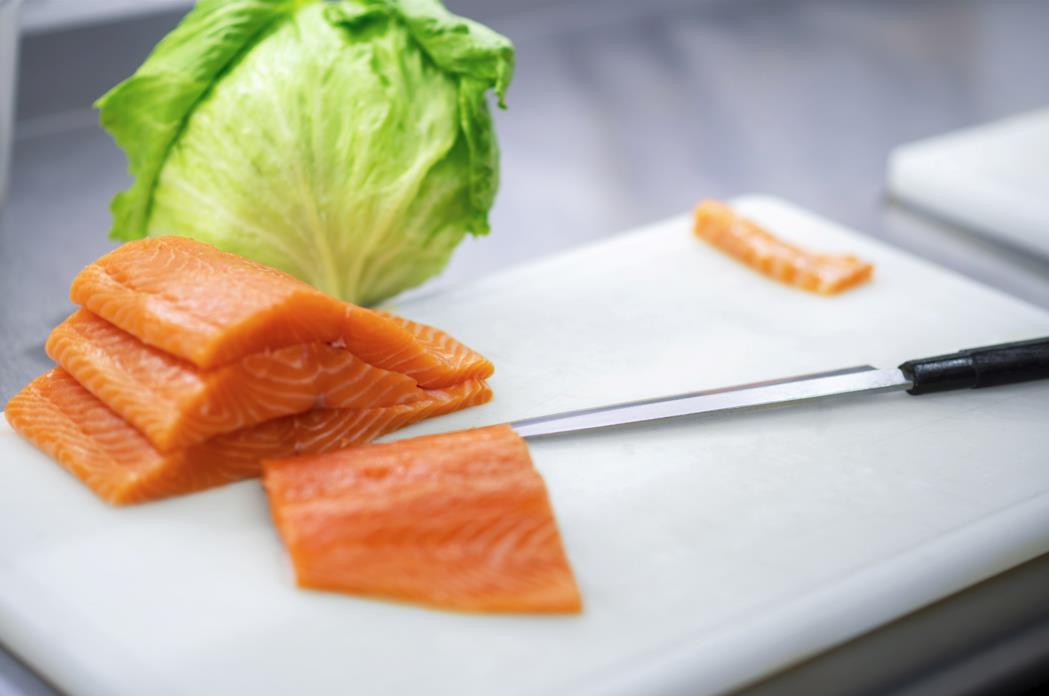Japanese knives have unique features that make them exceptional. They are lighter, thinner, yet harder. Many of the traits found in kitchen knives originating from Japan are different from German and French knives.
This article will break down everything you need to know about Japanese knives and various varieties, go over the differences that separate them from traditional Western kitchen knives, and answer commonly asked questions.
Table of contents
What are Japanese knives?
We have different names for various types of knives that feature a distinct blade design with a specific purpose, such as paring knives, utility knives, chef’s knives, etc.
The same goes for Japanese kitchen knives. Numerous Japanese kitchen knives are designed for a specific intent in mind; gyuto, kiritsuke,sujihiki, santoku, to name a few. Some of these knives are like chef’s knives but with features of their own that make it favorable to cooks who similarly use their knives.
While we’ll get to these differently built knives in a moment, we first need to look at the main features of Japanese kitchen knives. The blade and handle design isn’t the only distinction between them and kitchen knives in other parts of the world. It’s vital to identify their primary features to better understand what makes Japanese knives special.
Main features of Japanese kitchen knives
When we look at Japanese knives, the blade design is the first thing that catches our eyes. There is more to Japanese kitchen knives than just how the blade is built. The type of steel used, the way the edge is formed, hardness, and numerous details that seem minor are what make Japanese knives unique. Here are some of the characteristics of these great kitchen knives.
Knife’s edge
A blade’s edge is one of the most critical factors determining its sharpness and use. After all, it’s the part of the knife that cut and slice. The angle of the edge also dictates how you sharpen and hone.
The overwhelming majority of Japanese knives are single beveled. The bevel refers to the angle the blade has been ground to form the edge. The single bevel kitchen knives have one side of the edge straight, and the other is the cutting edge. This gives us a thinner edge that helps make more refined slices.
Originally, Japanese knives almost always had a single bevel edge, but many Japanese knives come double-beveled with today’s demand. While single bevel kitchen knives are easier to sharpen and hone, you might want to opt out for a double-bevel instead if you’re not keen on upholding extra care to your knives, especially if you’re a novice cook.
Single bevel vs. double bevel

The cutting edge’s angle is formed on both sides in double bevel blades, creating a V shape. Double bevel knives move the foods you cut on both sides. This type of edge is more versatile and sturdier in some ways.
While a double bevel edged knife won’t have problems cutting larger and denser ingredients like thick vegetables, where a single bevel knife may tear it into pieces.
A single bevel knife moves ingredients to one side. This creates consistent cuts and is why single bevel Japanese knives are great for making delicate cuts.
Which one is better?
Depending on the task performed, one will surely be a handier option, but these differences don’t make either one better than the other. It’s a matter of what you do with the knife rather than how you do it, as you can’t control how the edge slices through the ingredients.
Although most Japanese knives have a single bevel edge, it isn’t hard to find one that usually comes with this type of edge the other way around. If you see one for your liking, you’ll be able to find both alternatives, though some varieties might be harder to find.
Handpicked for you
True cutting power in the palm of your hand
Blade’s steel
The steel is perhaps the most crucial aspect of what makes a great knife. The Japanese knew this for a long time and kept the same primary steel used to make their knives – high carbon steel. To this day, high carbon steel remains the preferred choice of professional Japanese chefs.
This isn’t to say that all Japanese knives are high carbon steel. Other steels, such as stainless steel and high carbon stainless steel, are still prominent, like Western kitchen knives. These Japanese knives are more for home cooks that like the convenience of the anti-corrosion properties the Chromium brings, as true carbon steel requires more upkeep.
Tamahagane
High carbon steel is widely used, but it has variations that the Japanese have made to create their blades. One of these steel varieties is tamahagane, translating to precious steel. Although Japanese steels follow similar procedures to make them, tamahagane is one of the oldest. This steel has been around since the end of the Edo period – the time Japan kept its doors closed from the world until 1868.
Tamahagane is made from iron sand, usually using masa satetsu due to its higher quality, mainly found in Shimane, Japan. This steel has up to 1.5 percent carbon content. Considering any steel with more than 0.7 percent carbon content is what we call high carbon steel, Tamahagane steel has twice as much, making it exceptionally hard steel for making knives.
Knives made from tamahagane steel are valued for their hardness and the effort required to make the material. It takes 36 to 72 hours to produce a sizable amount that involves a continuous multi-step process.
Different types of Japanese kitchen knives
All these different things discussed so far make Japanese knives unique and diverse. As there isn’t a single type of Japanese kitchen knife, let’s go over some of the commonly used varieties and others that are more for specific tasks.
Common types
The list below features the common types of Japanese kitchen knives used for all purposes, essentially the Japanese equivalent of standard chef’s knives.
Santoku

Santoku is a versatile Japanese knife. Its name literally translates to the knife of three virtues. You may ask why it’s named like this – well, the santoku is the go-to knife for preparing vegetables, fruits, fish, and meat to chop, dice, and mince. Santoku is shorter in size than chef’s knives, with a blade generally ranging from 6 to 8 inches.
Learn more about the Japanese santoku.
Gyuto

Gyuto is basically the Japanese version of a standard chef’s knife. It was initially used solely to cut beef, but it had evolved a lot over the years since the first chef’s knives arrived in Japan during the Meiji Period.
Most professional chefs utilize high-end gyuto knives in the kitchen as they are lighter and put less strain on the wrists. Gyuto knives have the main attributes of any other chef’s knife, but since they are prevalent among chefs, varieties of this knife with softer steels and Western handles are common in shops.
Learn more about Japanese gyuto knives.
Kiritsuke
Kiritsuke features a flat edge mainly used for slicing fish and chopping vegetables. These knives have long blades that resemble a sword, and the spine tapers to a steep pointy tip.
Due to the flat edge, it doesn’t allow much movement on the cutting board. For example, you can’t chop vegetables by rocking the blade, but this isn’t something that Japanese chefs prefer doing anyway. In the Japanese way of cutting, chefs cut by moving the knife up and down, making the Kiritsuke’s edge ideal.
Bunka
Bunka is a general-purpose Japanese kitchen knife similar to kiritsuke and santoku. In many ways, it’s more similar to kiritsuke but has a wider belly. The triangle-shaped end of the blade is suitable for making intricate cuts when working with fish and meats. If you’re looking for something in between santoku and kiritsuke, the Japanese bunka knife is possibly the best option.
Specialty types
Besides the all-purpose Japanese knives, there are others for specialty tasks like precision work or another singular objective. These knives are rarer than the above as they are primarily for professional chefs that require more accuracy than a home cook.
Yanagi

Yanagi is mainly known as the sushi knife. It’s primarily used for slicing raw fish. The thin, long blade cuts through large fish effortlessly. The slim structure and sharp tip also make it great at precision work. The blade design isn’t great for fish. Yanagi makes a great steak knife, though with a rather long blade ranging between 8 and 13 inches.
Sujihiki
Similar to yanagi, sujihiki is mainly for carving and slicing large fish and meat. It has a thin, long blade with a flat edge and the same triangle-shaped end as bunka and kiritsuke. This part and the considerably long thin blade make it an exceptional knife at trimming and detail work, much like a slicer knife.
Nakiri
Nakiri is a distinct Japanese knife with a rectangular shape. The blade is exceptionally thinner than most other kitchen knives, making it ideal for creating thinly sliced vegetables and fruits. As the edge is flat, it makes contact with the cutting board entirely, ensuring the slices don’t break apart and stay intact. With a blade length ranging from 4 to 10 inches, there is a rightly sized Nakiri for every cook.
How to choose a Japanese kitchen knife?
Finding the right Japanese kitchen knife or knives to replace the old cutters and furnish your kitchen with brand new ones shouldn’t be hard. Considering the wide variations available, you can easily determine which Japanese kitchen knife would be the right pick for you. Like choosing any other kitchen knife, understanding your needs is the key.
Other than what you’re going to do with the knife and blade design, don’t forget to consider what comes after it. Some kitchen knives need more upkeep than others. This mainly depends on the steel and handle material, but other variables go into this also.
A knife isn’t just a handle and a blade. The blade may extend entirely through the handle, creating a what’s known as full tang handle or could be partial. Some knives have bolsters, and these could be semi or full. These are just some of the things to consider. Make sure to take a look at the following articles for more on finding the right kitchen knife.
How to choose a chef’s knife like a chef?
Best Kitchen Knives (Updated for 2022)
Differences between Japanese and Western knives

By now, you should have a basic understanding of the features that make Japanese kitchen knives unique. Japanese knives are lighter, thinner, and have a harder blade. On the other hand, Western kitchen knives are usually made from stainless steel, have a heavier weight, and have prominent bolsters.
While Japanese chef’s knives come with various options in blade profile, Western alternatives are typically similar. They have a wide blade from the heel that curves to a sharp pointy tip. Though it isn’t always like this in Japanese knives, some feature a similar profile.
These characteristics aren’t always the opposite. Some of the Western and Japanese knives have their fair share of similarities.
As the Japanese handles (wa-handle) are a lot different from those equipped on Western blades, some chefs have a hard time adapting. That’s why Japanese knife manufacturers have Western knife handles installed on Japanese blades as an option. This makes them appeal to a broader audience, including those that aren’t accustomed to the hexagonal Japanese handle.
FAQs
How to sharpen a Japanese knife?
You may need to sharpen a Japanese knife differently due to the bevel. If it’s a single bevel Japanese knife, sharpen at a 15 to 20 degree angle. The right sharpening angle is broader for double bevel knives, between 20 and 30 degrees. As you move the blade on the whetstone, have a feel for it. When sharpening at the wrong angle, it won’t move as smoothly and make the consistent sounds you want to hear throughout sharpening. Lastly, sharpening only one side is adequate with single bevel knives.
How to hone a Japanese knife?
Honing is just as important as sharpening. Though it won’t produce a brand new cutting edge, it will realign any edge parts out of order, giving you a sharper blade. The same as sharpening a single bevel Japanese knife, honing only one side is enough. If the other way around, hone both sides. Find the right honing angle by stroking the honing rod at different angles and see if it wants to move in that direction. Even if you feel a slight pushback, you’re doing it wrong. Change the angle until the strokes are consistent.
How to store Japanese knives?
Japanese kitchen knives are a lot more fragile than their Western counterparts. The hardened high carbon steel is susceptible to chipping under harsh conditions. It’s best to use a dedicated knife block or magnetic strip to store not just your Japanese knives but any other. Never leave your knives in the drawer with blades rubbing on each other. Learn more about proper knife storage methods.
Final words
Japanese kitchen knives are great, and they can make life a lot easier when making refined slices to cook foods evenly and have better-looking dishes in the end. With the wide variety of options available, you can find the perfect Japanese knife for your cutting style.
The right kitchen knife should aid you in every aspect of preparing meals. Take a look at our handmade knives collection to find appropriate options and read more on the HDMD Knives blog.












